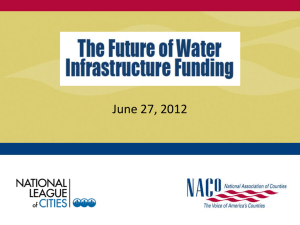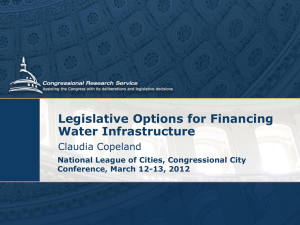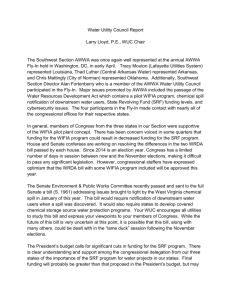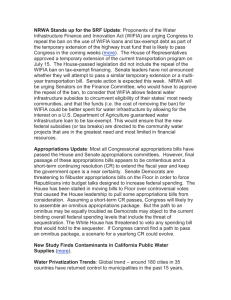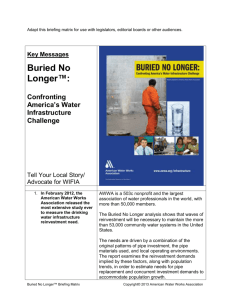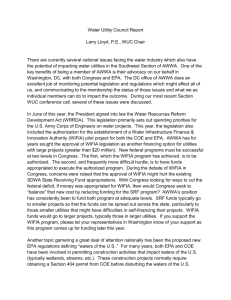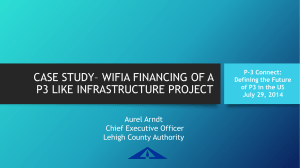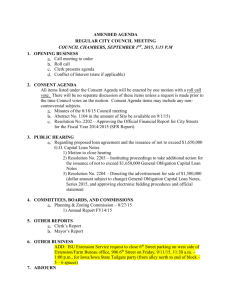The SRFs and WIFIA - American Water Works Association
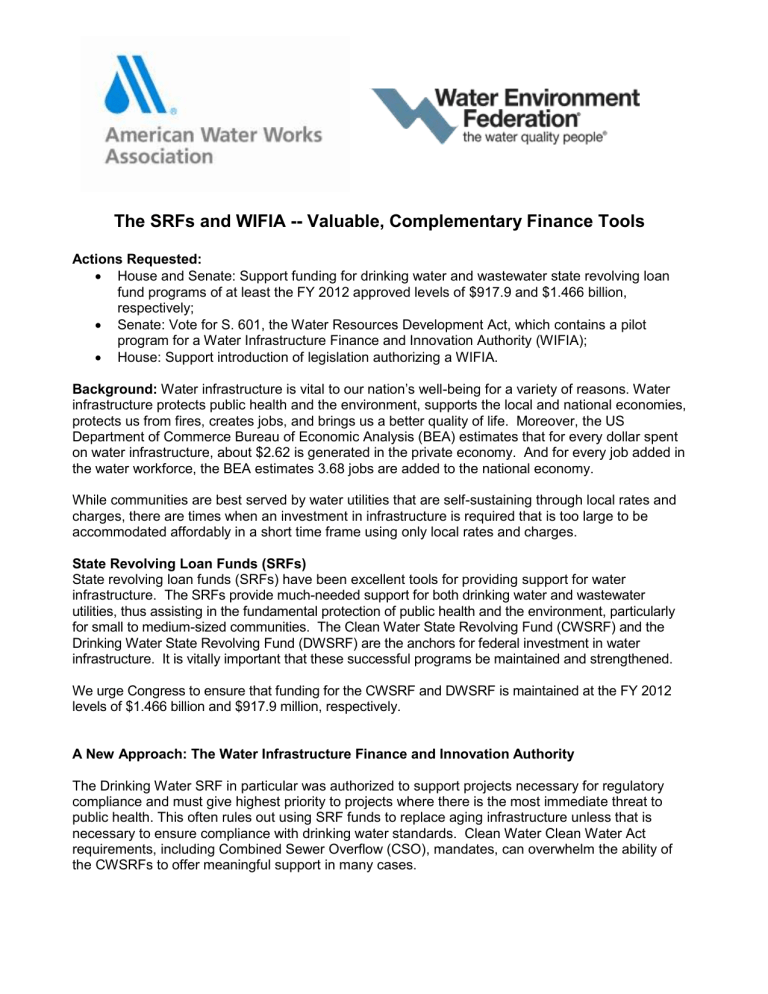
The SRFs and WIFIA -- Valuable, Complementary Finance Tools
Actions Requested:
House and Senate: Support funding for drinking water and wastewater state revolving loan fund programs of at least the FY 2012 approved levels of $917.9 and $1.466 billion, respectively;
Senate: Vote for S. 601, the Water Resources Development Act, which contains a pilot program for a Water Infrastructure Finance and Innovation Authority (WIFIA);
House: Support introduction of legislation authorizing a WIFIA.
Background: Water infrastructure is vital to our nation’s well-being for a variety of reasons. Water infrastructure protects public health and the environment, supports the local and national economies, protects us from fires, creates jobs, and brings us a better quality of life. Moreover, the US
Department of Commerce Bureau of Economic Analysis (BEA) estimates that for every dollar spent on water infrastructure, about $2.62 is generated in the private economy. And for every job added in the water workforce, the BEA estimates 3.68 jobs are added to the national economy.
While communities are best served by water utilities that are self-sustaining through local rates and charges, there are times when an investment in infrastructure is required that is too large to be accommodated affordably in a short time frame using only local rates and charges.
State Revolving Loan Funds (SRFs)
State revolving loan funds (SRFs) have been excellent tools for providing support for water infrastructure. The SRFs provide much-needed support for both drinking water and wastewater utilities, thus assisting in the fundamental protection of public health and the environment, particularly for small to medium-sized communities. The Clean Water State Revolving Fund (CWSRF) and the
Drinking Water State Revolving Fund (DWSRF) are the anchors for federal investment in water infrastructure. It is vitally important that these successful programs be maintained and strengthened.
We urge Congress to ensure that funding for the CWSRF and DWSRF is maintained at the FY 2012 levels of $1.466 billion and $917.9 million, respectively.
A New Approach: The Water Infrastructure Finance and Innovation Authority
The Drinking Water SRF in particular was authorized to support projects necessary for regulatory compliance and must give highest priority to projects where there is the most immediate threat to public health. This often rules out using SRF funds to replace aging infrastructure unless that is necessary to ensure compliance with drinking water standards. Clean Water Clean Water Act requirements, including Combined Sewer Overflow (CSO), mandates, can overwhelm the ability of the CWSRFs to offer meaningful support in many cases.
An additional tool is needed that can support large, regional water and wastewater projects at a small long-term cost to the federal government. The new tool must be designed to complement – not replace – the SRFs. That tool is the Water Infrastructure Finance and Innovation Authority
(WIFIA). Lowering the cost of borrowing by 2.5 percent on a 30-year loan reduces the lifetime project cost by over 25 percent, the same result as a 25-percent grant. These savings for local borrowers can significantly accelerate needed water infrastructure investment by making it more affordable for utilities and their customers.
The Senate Committee on Environment and Public Works has addressed the challenge of financing large, regional projects and sent to the full Senate S. 601, the Water Resources Development Act of
2013. Title X of this bill would create a pilot program for a Water Infrastructure Finance and
Innovation Authority (WIFIA).
WIFIA would assist communities in meeting the nation’s water infrastructure needs in a manner that minimizes the cost to the federal government while complementing the SRFs and other financing mechanisms, maintaining the current federal role, leveraging private capital, and creating vital manufacturing and construction jobs. WIFIA would access funds from the U.S. Treasury at long-term
Treasury rates and use those funds to provide loans, loan guarantees, or other credit support for water infrastructure projects. Loan repayments – with interest – would flow back to WIFIA and thence back into the Treasury.
Eligible water infrastructure projects would include drinking water, waste water, storm water, water reuse and desalination, and similar projects, and associated water infrastructure replacement and rehabilitation.
Under S. 601, WIFIA would have the authority to:
Provide direct loans, loan guarantees, and lines of credit for large water infrastructure projects, with a minimum loan size of $20 million. That ensures that WIFIA complements but does not replace the SRF program by specifically focusing on larger projects that may be unable to access capital through the SRFs.
Provide state authorities with the ability to apply for a WIFIA loan to fund an aggregation of smaller projects. This allows states to utilize WIFIA to leverage existing SRF resources.
One of WIFIA ’s key features is the minimal long-term cost to the federal government and the high leverage available against the federal appropriation. Under the Federal Credit Reform Act, a federal entity can provide credit assistance to the extent that Congress annually appropriates budget authority to cover the “subsidy cost” of the loan, i.e. the net long-term cost of the loan to the federal government. In this way, Congress directly controls the amount of lending – but appropriated funds support many times their value in low-interest loans, ensuring that the program is efficient, effective, and highly leveraged.
We urge you to support legislation to fully reauthorize the Clean Water and Drinking Water SRF and the enactment of WIFIA legislation similar to that reported by the Senate Committee on Environment and Public Works.
###
